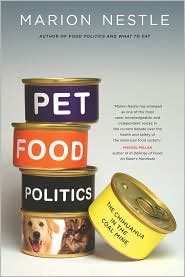As the year past us begins to fade, the beginning of a new year presents us with opportunities to both assess the past and establish goals for the future. 2012 was particularly difficult for us; we had to say final goodbyes to many companions. To all who left us last year, we loved you and we cried for you and we will miss you dearly. You will be in our hearts forever. But we're optimists at heart. The past year also brought us many new friends, and we know 2013 will bring us even more. We look forward to coming up with new ways to improve on the care and comfort that we provide. We hope and wish for you and your family a healthy and happy 2013.
A quick reminder..
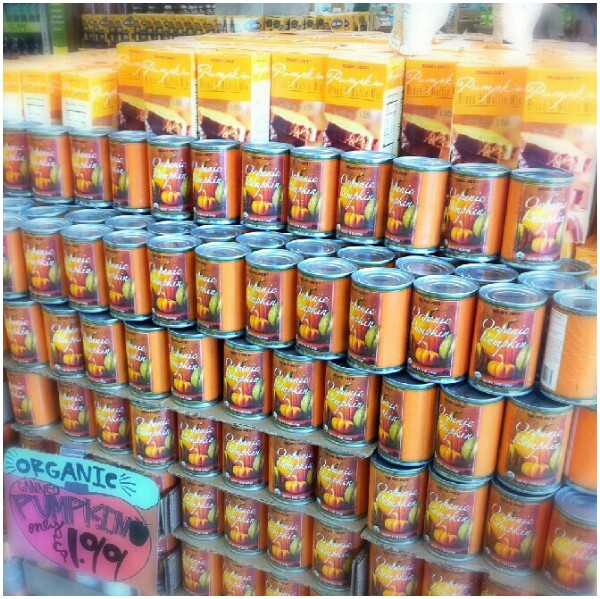
If your veterinarian has prescribed or recommended canned pumpkin for your pet, now is the best time to stock up on it.
When is DM not DM?
DM is Dietetic Management Feline Formula from Purina Veterinary Diets. We refer to canned DM as the Diabetic Management diet for cats -- it is a critical part of our management of this disease. For more information on diabetes, please refer to this article on VeterinaryPartner.com.
How different therapeutic diets can help manage diabetic patients was one of the reminder to us that "cats are not small dogs" when it comes to disease process and treatment. Years ago, veterinarians recommended high fiber diets for diabetic cats, as we do for dogs. High fiber diets usually mean high carbohydrate. We since learned that, unlike dogs, diabetic cats do better on a low carbohydrate high protein diet. Since dry food requires some sort of flour (be it corn, rice, soy, barley, wheat, etc.) to make it crunchy and to form the kibble, it tends to be higher in carbohydrate. So even though there is a dry DM formula, the canned DM is ideal --- until recently when Purina introduced the new DM Savory Selects "for cats who prefer meaty chunks topped with gravy."
What's wrong with introducing a new formula to add variety to a diabetic cat's diet? The chunky Savory Selects does look more appetizing with the juicy gravy:
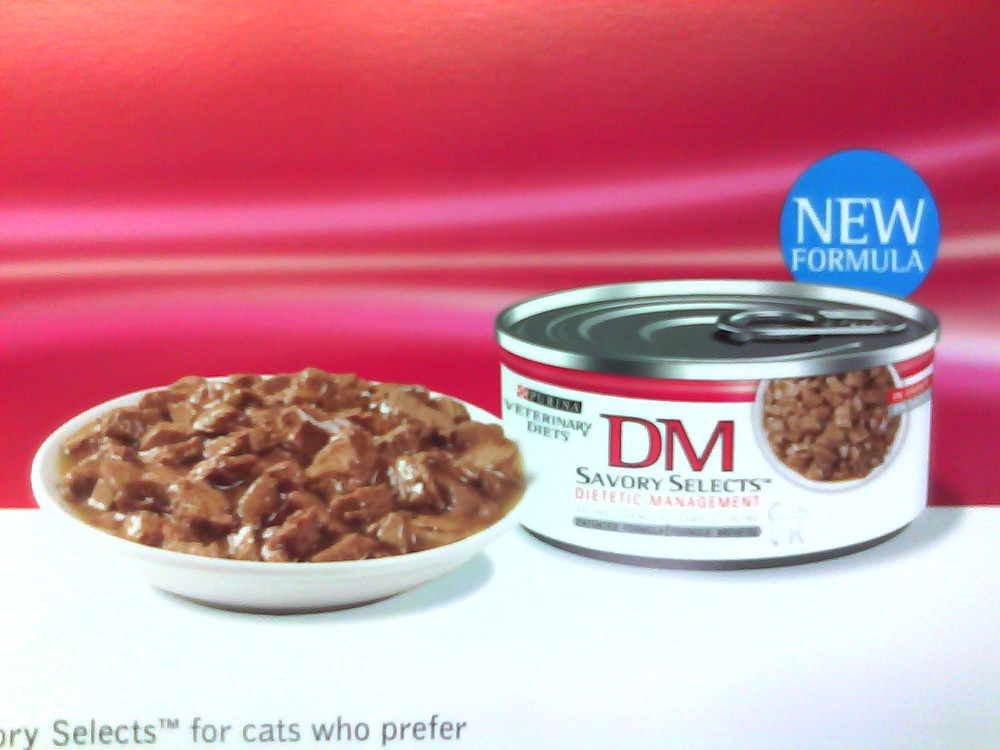 DM Savory Selects Dietetic Management Have you ever made or watched someone make gravy from scratch? Flour or cornstarch is usually added to thicken the sauce. In DM Savory Selects, cornstarch is added to make that gravy --- and, subsequently, more than doubles the carbohydrate amount compared to the original canned DM formula.
DM Savory Selects Dietetic Management Have you ever made or watched someone make gravy from scratch? Flour or cornstarch is usually added to thicken the sauce. In DM Savory Selects, cornstarch is added to make that gravy --- and, subsequently, more than doubles the carbohydrate amount compared to the original canned DM formula.
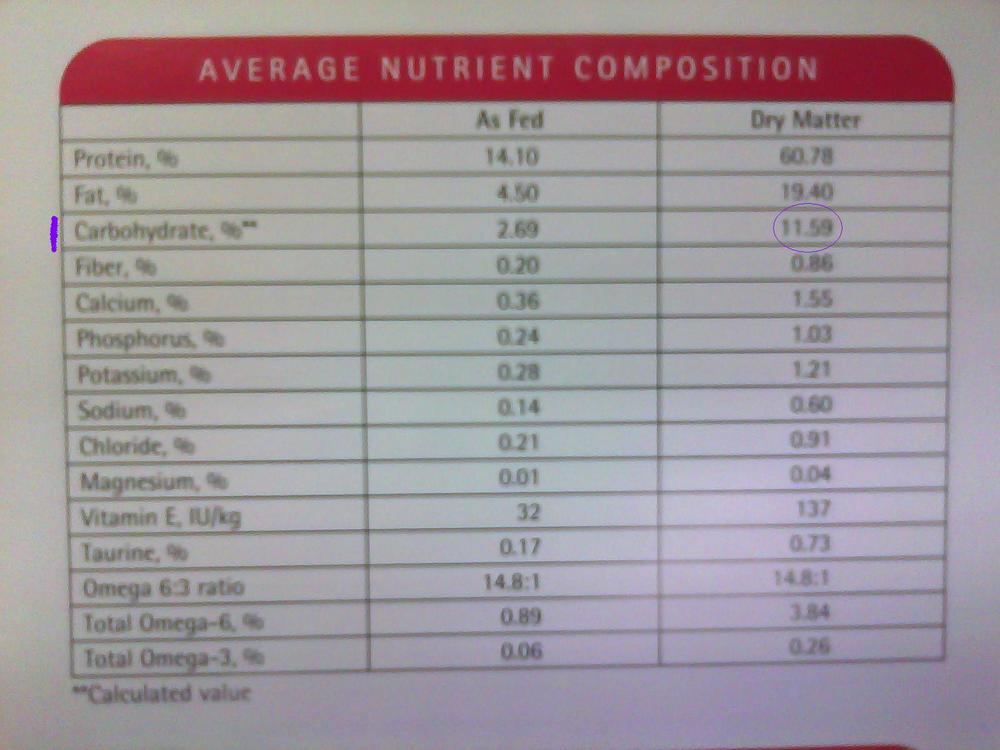
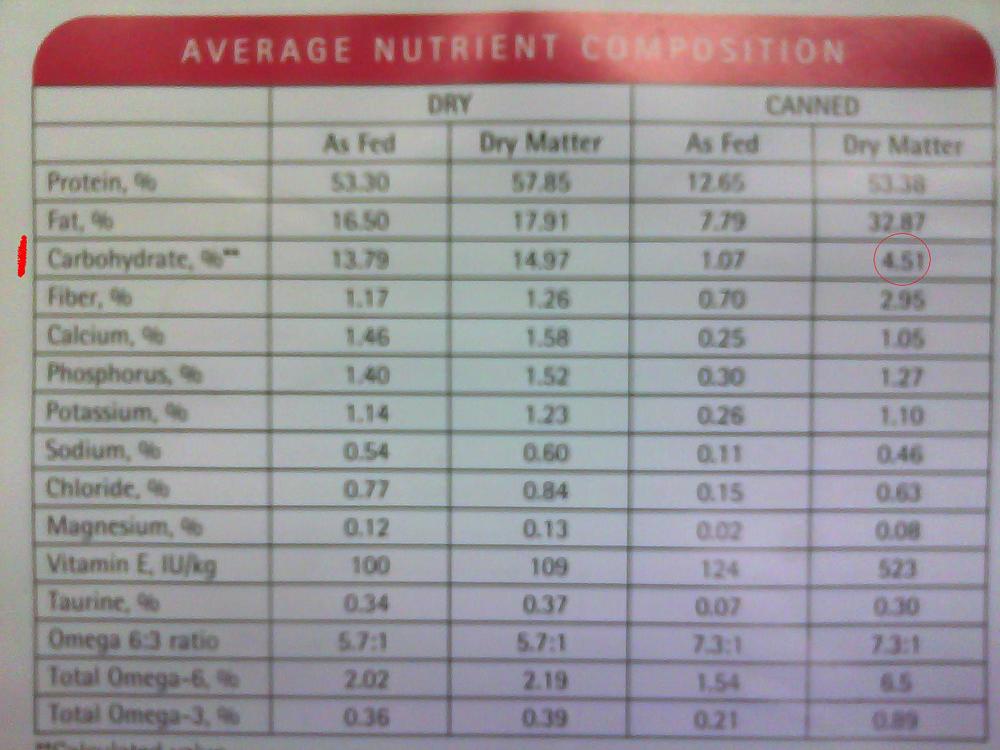
11.59% carbohydrate (on a dry matter basis) is not that bad but you can find similarly low carbohydrate diets in certain over-the-counter canned food. Some are even lower in carbohydrate than the DM Savory Selects.
We have seen the effectiveness of the canned feline DM diet. The diabetic cats in our care that went into remission (becomes non-diabetic) have all had DM as part of their treatment. The cats that did not seem to respond to insulin eventually did after his family managed to convince him to eat canned DM. We have diabetic cats that are doing well on the canned low carbohydrate over-the-counter food in the above linked chart --- but years later, they are not in remission (and unlikely to do so). So some of the diets in the chart are alternatives for cats that will not eat canned DM (the original formula) but they cannot compare to DM.
Which is why we could not understand why Purina would make a different formula with a different nutrient profile but kept the same name. It's fine to come up with a more appetizing formula but if it has a different nutrient profile --- twice the carbohydrate percentage of its original formula --- the diet should have a completely different name. Or hyphenate it to something like DM-moderate (for moderate carbohydrate). Calling it DM Savory Selects is not differentiating it enough; it sounds too much like a new flavor.
Where's the harm?
A well regulated cat on canned DM can become unregulated if fed a higher carbohydrate diet. A previously diabetic cat that is now in remission, thanks to canned DM and his family's diligence, can come out of remission (becomes diabetic and needing insulin injections again) if his family unknowingly feeds him a higher carbohydrate diet.
And in this age of online pharmacies, that can easily happen:
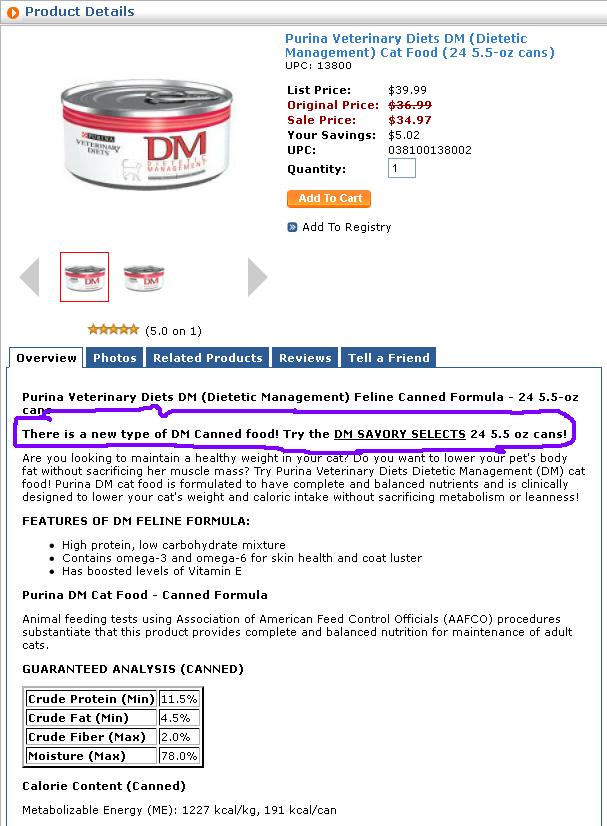
DM Savory Selects may be fine for cats who will not eat canned DM. DM Savory Selects may be a good choice to transition cats onto canned DM. But it should be made clear that
DM Savory Selects is not canned DM.
We have relayed our concerns to our Purina representative so, hopefully, something will be done about this -- be it a change in labeling to differentiate the two formulas and/or Purina telling veterinarians about this so we can all write on our written prescriptions "NOT DM Savory Selects" when we want our patients to have the original canned DM formula.
Until then, please pass this information along to your veterinarians or families with diabetic cats -- especially cats who are currently on canned DM or other low carbohydrate canned diets.
Purina Feline DM is a diet that is deserving of the term therapeutic or prescription diet. It plays an important role in the management of diabetic cats. It would be a shame if any lack of success with DM Savory Selects mars the reputation of the original DM or worse, makes people doubt that diet does make a difference in the life of a diabetic cat.
Microchips

Friday May 11th provided a good reminder to us why microchips are a simple yet powerful tool that we recommend for all of our patients. In the morning one our clients contacted us to let us know they found a stray dog. They scheduled an appointment and brought the friendly cocker spaniel for a microchip scan. The scan confirmed that a chip was present, and after a few phone calls our clients were able to reunite the wayward dog with his grateful owner.
Unfortunately, only about an hour later we received a call from Long Beach Animal Care services that they had found a cat recently deceased (probably hit by a car) with a microchip that may had been implanted by us. Even though we had implanted the chip 14 years ago, we were able to provide Long Beach Animal Care with the appropriate owner information so that they, in turn, could provide the owner with some closure. Pet microchips can save lives and reunite companions. There are several major microchip manufacturers and several registration options, so make sure to ask your veterinarian about microchipping options for your companions.
Book Review: Pet Food Politics: The Chihuahua in the Coal Mine by Marion Nestle
Many pet owners remember that beginning in March 2007, many major pet food manufacturers began recalling popular lines of pet diets. Iams, Eukanuba, and Blue Buffalo were among the many popular brands of dog and cat food that were pulled from the shelves of grocery stores, pet stores, and veterinary offices. Anger and confusion set in among many pet owners, as foods that had been promoted as safe and healthy for our companions were removed and considered possibly dangerous. Understandably, many pet owners felt betrayed and lost trust in pet food manufacturers. Worst of all, many dogs and cats lost their lives from eating contaminated product.
Pet Food Politics begins by tracing the roots and causes of the recall. Many pet food companies, as it turns out, outsource the manufacturing of their pet foods to a pet food manufacturer. The manufacturer produces the foods in accordance with the companies' manufacturing specifications (the "recipes," so to speak). By producing many companies' pet foods, a manufacturer (such as Menu Foods) can take advantage of economies of scale to purchase ingredients for less and consolidate production to usually produce the foods at a cheaper cost than the pet food companies could do on their own. (Thus, at least up until the recall, many of the "high end" foods including varieties of Science Diet, Royal Canin, and Natural Balance were made by the same manufacturer that made low-cost competitors such as Walmart's Old Roy.)
Like many other products, many pet food ingredients such as wheat gluten are often available for less overseas. Menu Foods purchased its wheat gluten from Chinese companies. Oftentimes, food manufacturers find it easier to deal with a "go-between" or broker, that specializes in obtaining the low-cost overseas products for them rather than dealing with the ingredients' producers themselves. One of these companies, ChemNutra, provided Menu Foods with wheat flour that had melamine added to make it appear as the much more expensive wheat gluten.
Shortly after the food recall was first announced, Cornell researchers discovered that elevated melamine was common to the foods in the ill and dying patients. They remained perplexed however, as the only research available on melamine (all old, out of date studies), showed that it was dangerous only at much higher levels. It took a few more weeks for veterinarians at UC Davis to discover that, when mixed with the compound cyanuric acid, melamine was dangerous even at much lower doses.
As alarming as the background behind the recalls is, Nestle also details corporations quick to claim innocence and denial. All of the major players denied responsibility and tried to shift blame to others. Consider that at one point or another:
-Menu Foods blamed ChemNutra for the laced wheat "gluten" it used.
-ChemNutra claimed innocence, and stated they were only "brokers" and were never owners of the product themselves.
-Xuzhou Anying ("owners" of the product that ChemNutra provided Menu Foods), stated that they too, didn't actually manufacture product, only purchased it themselves from 25 manufacturers throughout China. Even worse, Xuzhou Anying officials were at one point quoted as stating "The poisoning of American pets has nothing to do with China."
Sadly, neither Nestle nor the FDA were able to find the actual manufacturers of the laced product, and, given the complexities of our food supply, are unlikely to ever do so.
I strongly recommend Pet Food Politics. It's part mystery, part drama, and part tragedy. It tells of a mystery illness that seemingly came out of nowhere to claim hundreds, maybe thousands, of lives. It details the drama of veterinarians, universities, pet food companies, and an understaffed FDA racing to find a cause. The tragedy is not without its villains (you'll have to read it to see who were the most egregious offenders) and its heroes: Nestle singles out the pet food maker Castor and Polluck's, the San Francisco based pet store Pet Express, and Internet journalists for being open and proactive during at the height of the crisis. (The FDA, severely underfunded and under tremendous pressure from the public, journalists, and pet food companies, also comes across fairly well.) Finally, it's a cautionary tale: Nestle details the major reforms that are needed in the way we deal with food production, both for pets and humans, if we're to avoid future episodes. And, given the interconnections of our food supply, one that can't simply be solved by avoiding pet foods altogether.
